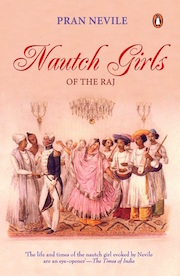Nautch Girls of the Raj
Pran Nevile
 Pran Nevile’s book is no intellectual heavyweight though he claims to have examined ‘every factor — historical, socio-economic and cultural — that contributed to the rise and fall of the nautch girl’ (Nautch being a corruption of naach) and to have arrived at conclusions regarding the demise of this class of professional entertainers after a thorough examination of books, memoirs, journals, diaries, and visual records of the period.
Pran Nevile’s book is no intellectual heavyweight though he claims to have examined ‘every factor — historical, socio-economic and cultural — that contributed to the rise and fall of the nautch girl’ (Nautch being a corruption of naach) and to have arrived at conclusions regarding the demise of this class of professional entertainers after a thorough examination of books, memoirs, journals, diaries, and visual records of the period.
Yet, he does not include the perspective of the women themselves regarding their profession. Many biographical and fictional accounts of women in the entertainment industry were written in the 19th century as well as later.
There is not even a passing reference to Ruswa’s well-known late 19th century novel, Umrao Jaan Ada about a young girl who was kidnapped from her home in Faizabad and sold to a brothel in Lucknow. Perhaps the reason Nevile doesn’t quote any such references is that they would tarnish the romantic image he wants to portray of the 19th century tawaif as a well-respected member of society; ‘an accomplished and refined person with poetry and dance in her blood.’
Nautch Girls of the Raj is more of male-centric nostalgia for the good old days when British officers, local nawabs and landowners could boast of harems full of dancing and singing women, who also doubled as their sexual slaves.
Nevile glibly refers to these women as presents, property and possessions that were exchanged, purchased, or gifted ‘as a mark of hospitality by native rulers and princes’ to the English. He quotes extensively from verses by Englishmen entranced by the seductive charms of the nautch girls.
There is a whole chapter devoted to the description of nautch parties given by rajahs and nawabs, another on the fabled beauty and charms of these celebrated girls, and one on their lifestyle, customs and rituals — with descriptions of costumes, cosmetics, and gravity-defying devices that were used to preserve their figures.
When they were not entertaining their esteemed guests, the girls, according to Nevile, whiled away their days by rising late and spending ‘long afternoons either in chatting with the musicians or going out for shopping in the bazaars.’ This beguiling image depicting the courtesan as a lady of leisure seems to have been borrowed, not from biographies or memoirs of 19th century nautch girls, but from Bollywood-fed fantasies.
The author appears to be mourning the demise of art forms such as kathak dance and classical singing as a corollary of the anti-nautch movement launched in late 19th century India. He blames the spread of English education and the reformist zeal of the ‘petit bourgeois class’ which, under the colonising influence of western ideas, grew increasingly intolerant of its own arts and cultural traditions.
The arrival of British women and missionaries in large numbers in India and the burgeoning activism of the Indian women’s movement sounded the death knoll of the nautch tradition. But the author refrains from commenting on the sexual colonisation of vast numbers of women dancers and singers who were compelled to serve as sexual consorts and thus suffered from disease, violence and indignity.
Nevile’s writing is at best inaccurate, and at worst, a vicarious peep show, with wistful longing for a bygone era when the tawaif was an accomplished artist who regaled her clients with a more varied and satisfying fare — dance, song and long evenings filled with flirtatious titillation of the senses.
He is only concerned with a certain class of entertainers and makes it clear that though the British conflated ‘common bazaar prostitutes and strolling dancing girls’ under the appellation ‘nautch girl’, he is only referring to those who were ‘taught to read and write, appreciate poetry, participate in polite conversation and have refined manners — [who] conducted themselves with dignity, commanding respect in society.’
No mention, of course of where he gets this data, or of what percentage of women in the entertainment industry commanded such respect. Even a cursory reading of the literature of the period, for example Premchand’s Courtesan Quarters, or Ruswa’s Umrao Jaan Ada would reveal the paucity of respect and dignity accorded to the tawaif irrespective of her educational and artistic refinements.
A more accurate view of 19th century women in the sex industry is offered by Geraldine Hancock Forbes. Commenting on the colonial economy’s role in promoting exploitative employment for large numbers of Indian women at the turn of the 20th century, she writes in Women in Modern India, ‘Women’s new professional opportunities as well as their employment in urban brothels were a consequence of British domination. Colonial rule transformed the traditional economic system and in the process fundamentally dislocated the non-agricultural, village-based economy. The decline of the local economy and with it the demise of local small-scale services and industries left many women unemployed.’
So what did these large numbers of dislocated, unemployed women do? They drifted to the cities and many ended up in brothels. For example, by the middle of the 19th century, writes Forbes, there were more than 12,000 prostitutes in Calcutta. And here is an even more startling fact 90 per cent of them were widows.
Of these large numbers of economic refugees, only a few may have been fortunate enough to have ended up as independent, respected, dancer-poet-singer courtesans — the subject of Nevile’s book.
